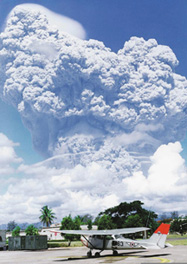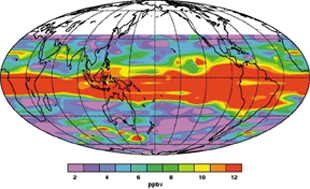Geotimes

Geophenomena
Mount
Pinatubo: A Natural Climate Experiment
Lisa M. Pinsker
 Mount Pinatubo
in the Philippines erupted on June 15, 1991. Spewing 20 million tons of sulfur
dioxide into the atmosphere, Pinatubo’s eruption had the largest atmospheric
impact of any volcano in the 20th century. Over the past decade, atmospheric
scientists have used Pinatubo to explore the profound effects volcanic eruptions
can have on Earth’s climate system.
Mount Pinatubo
in the Philippines erupted on June 15, 1991. Spewing 20 million tons of sulfur
dioxide into the atmosphere, Pinatubo’s eruption had the largest atmospheric
impact of any volcano in the 20th century. Over the past decade, atmospheric
scientists have used Pinatubo to explore the profound effects volcanic eruptions
can have on Earth’s climate system.
“It is the best volcanic test of the past century, because, at least in our
calculations, it is the largest volcanic forcing since Krakatau in 1883, and
the aerosol properties were observed much better than those of any other large
volcano,” says Jim Hansen, a climatologist at the NASA Goddard Institute for
Space Sciences. Using this test, scientists have discovered that volcanoes can
affect everything from global warming observations to ozone depletion.
Mount Pinatubo erupting in the Phillipines
on June 15, 1991. Courtesy of NASA Goddard Space Flight Center.
Alan Robock of Rutgers University has studied the impact of volcanic eruptions
on the atmosphere since 1972. He studied the aftermath of the eruption of Mount
Agung in 1963 and El Chichón in 1982. Echoing Hansen, he says “with Pinatubo,
we had the best observations so far on both the volcanic aerosols and the climate
system, and we had better models “
Data for Pinatubo came from such instruments as SAGE (Stratosphere Aerosol and
Gas Experiment) II, launched in 1984 on the ERBS satellite, that uses solar
occultation to observe the vertical distribution of upper atmospheric (stratospheric)
aerosols, ozone and water vapor around the planet. At the same time, ground-based
lidar (light detection and ranging) instruments measured aerosol distribution
from below. And NASA’s Upper Atmospheric Research Satellite was also on hand
to observe changes in the dynamics and energy balance in the layers of the stratosphere.
With these improved observational tools, Pinatubo’s eruption became a natural
experiment for climate change, Robock says. “If you had to write an environmental
impact statement before you did this experiment, you would never get approval.
Since we didn’t have a choice in it, we’re at least taking advantage of it to
learn more about the climate system and our models.”
Warming anomaly
Since the 19th century, a network of thermometers has measured surface temperatures
around the globe. These temperatures show that Earth’s surface has warmed considerably
over the past 20 years. At the same time, however, global temperatures from
satellites observing the air above the surface (lower troposphere) since 1979
show little or no warming. This discrepancy has fueled some controversy in both
scientific and political arenas over the reality of global warming. But volcanoes
could be the missing piece in this climate conundrum.
While Pinatubo’s eruption created an immediate fallout of particles near the
volcano itself, it also produced a 30-megaton cloud of sulfuric acid droplets
in the upper atmosphere (stratosphere). The sulfuric acid droplets are like
little cloud droplets that gradually fall out as they move around in the upper
atmosphere.
 “Within three weeks,
the aerosol cloud in the stratosphere circled the globe, about the same timing
it took for El Chichón,” Robock says, and the cloud stayed in the stratosphere
for about two years.
“Within three weeks,
the aerosol cloud in the stratosphere circled the globe, about the same timing
it took for El Chichón,” Robock says, and the cloud stayed in the stratosphere
for about two years.
On Sept. 21, 1991, sulfur dioxide from
the eruption of Mount Pinatubo three months earlier still stretched around the
globe. Pictured is the view from 26 kilometers high as compiled by the MLS (Microwave
Limb Sounder) instrument aboard the Upper Atmospheric Research Satellite. Courtesy
of NASA Goddard Space Flight Center.
The aerosol particles in the cloud reflected sunlight back to space, so less
sunlight reached the ground. Robock says that after Pinatubo, the whole planet
cooled for a couple of years, and it looked as though global warming was not
happening. “But actually our climate models, the same ones we use for global
warming, tell us that it should have cooled after Pinatubo and they tell us
that it cooled by about the right amount,” Robock says.
Ben Santer of Lawrence Livermore National Laboratory agrees and says that this
aerosol effect likely masked the past 20 years of global warming. He and his
colleagues have sought to compare climate models and observations by removing
the volcanic effects to reveal the human-induced warming.
In a paper published in the November Journal of Geophysical Research-Atmospheres,
they attempt to quantify volcanic influences on surface and tropospheric temperatures.
But, Santer says, the task proved difficult “because of the unlucky occurrence
of El Niño events at the same time as the volcanic eruptions went off.”
The eruption of El Chichón coincided with the largest El Niño
event of the century and the eruption of Mount Pinatubo occurred at the same
time as a smaller El Niño. “Just as volcanoes have likely masked some
of the human-induced warming of the climate system, El Niños have also
masked the volcano signal,” Santer says.
So, Santer’s team used a statistical procedure to separate the volcanic signal
from the El Niño signal in the temperature record, drawing on various
observations of sea-surface temperatures for El Niños and aerosol characteristics
for volcanoes.
When they put these isolated signals into climate models, they found a better
match between the models and the observations. “We couldn’t completely simulate
the greater warming of surface relative to troposphere, but we were much closer
to simulating that kind of behavior than experiments that did not include volcanic
effects,” Santer says. The volcanic signal may have provided the missing link.
Volcano-friendly modeling
Data on volcanic aerosols can also play a vital role in understanding the individual
processes within climate models. Researchers not only study the individual effects
of various volcanic emissions, but also use the volcanic signal to better explain
the climate system as a whole.
In new research, Robock is working with Georgiy Stenchikov, also of Rutgers,
to incorporate into models how volcanic emissions create ozone depletion.
Human-produced chlorine in the atmosphere reacts with stratospheric aerosols
to deplete ozone in both high and low latitudes. And, because ozone is a greenhouse
gas that absorbs solar radiation, it changes the temperature of the atmosphere
between the poles and the equator and can thus strengthen the jet stream. Stenchikov
says the volcanic ozone depletion causes the strongest jet stream effect in
the winter, when it brings warm air over the continents — much like another
climate phenomenon, called the arctic oscillation, or winter warming. “The ozone
effect on climate is fairly significant. It causes a delay of final warming,
and by itself is able to enhance the positive phase of the arctic oscillation,”
he says.
Stenchikov wants to “see how much of the climate response was caused just by
the aerosol effect and how much of the climate response was caused by the ozone
depletion,” Robock says. Stenchikov and Robock’s work is currently under review
by the Journal of Geophysical Research.
Similarly, Robock is researching the role of water vapor in Earth’s climate
system and is using Pinatubo as his experiment. “This was such a strong change
of climate and took place in a short period of time, so we could use this natural
climate experiment to see how water vapor did change and compare it to our models.”
By isolating Pinatubo’s temperature signal, Robock can better examine changes
in water vapor. Climate models rely on the idea that as temperature changes,
the amount of water vapor in the atmosphere changes, increasing with warmer
temperatures. As the most important greenhouse gas, the vapor creates a positive
feedback similar to that of ozone, amplifying global warming. Therefore, his
research could provide a valuable test of climate model sensitivity.
Bright future
The most startling idea to come out of the past 10 years of research on Pinatubo
is the degree to which volcanic eruptions can alter atmospheric circulation
and the climate system as a whole. Robock says volcanic emissions continue to
change our understanding of Earth’s climatic behavior in both the short and
the long term. Much work still lies ahead.
As satellite data continue to improve, so will our understanding of volcanoes’
role in the atmosphere. Robock is excited about the newly launched SAGE III
and is currently proposing the placement of a Lidar station on the equator to
look at volcanic aerosols. “If we had another Pinatubo today, we still wouldn’t
know very well what the distribution was in the tropics, because Lidar is the
only way to get a very good vertical distribution and there are several at about
19 degrees north in Hawaii, Cuba and China and one at 23 degrees south in Brazil.
But, in between there’s still a gap,” he says.
Robock next plans to go back in history to study Laki’s 1783 eruption in Iceland,
and Tambora’s eruption in 1815 — an eruption 10 times bigger than Pinatubo that
created “the year without a summer” in 1816. Without satellite observations,
it will be difficult, he says, but he has high hopes that their current models
will reveal a better understanding of the atmospheric effects of past eruptions.
Santer hopes our understanding of aerosol particle characteristics will continue
to improve. “When you try and simulate effects of these volcanoes on temperature,
you need to accurately specify what you think the properties of the aerosols
were … and some of these things are not very well known,” he says.
But, Santer says, the message from this body of work is that it is important
to include volcanic emissions in models in “the best way we possibly can.” And,
he says, more climate modelers, including Hansen’s group at NASA, are working
hard on refining volcanic particle properties for use in their models.
Pinatubo was a once-in-a-lifetime event for atmospheric scientists, Hansen says.
“The next large volcanic eruption should be observed even better, but we may
not get such a good one in our lifetimes.”
 Mount Pinatubo
in the Philippines erupted on June 15, 1991. Spewing 20 million tons of sulfur
dioxide into the atmosphere, Pinatubo’s eruption had the largest atmospheric
impact of any volcano in the 20th century. Over the past decade, atmospheric
scientists have used Pinatubo to explore the profound effects volcanic eruptions
can have on Earth’s climate system.
Mount Pinatubo
in the Philippines erupted on June 15, 1991. Spewing 20 million tons of sulfur
dioxide into the atmosphere, Pinatubo’s eruption had the largest atmospheric
impact of any volcano in the 20th century. Over the past decade, atmospheric
scientists have used Pinatubo to explore the profound effects volcanic eruptions
can have on Earth’s climate system. 
 “Within three weeks,
the aerosol cloud in the stratosphere circled the globe, about the same timing
it took for El Chichón,” Robock says, and the cloud stayed in the stratosphere
for about two years.
“Within three weeks,
the aerosol cloud in the stratosphere circled the globe, about the same timing
it took for El Chichón,” Robock says, and the cloud stayed in the stratosphere
for about two years. 